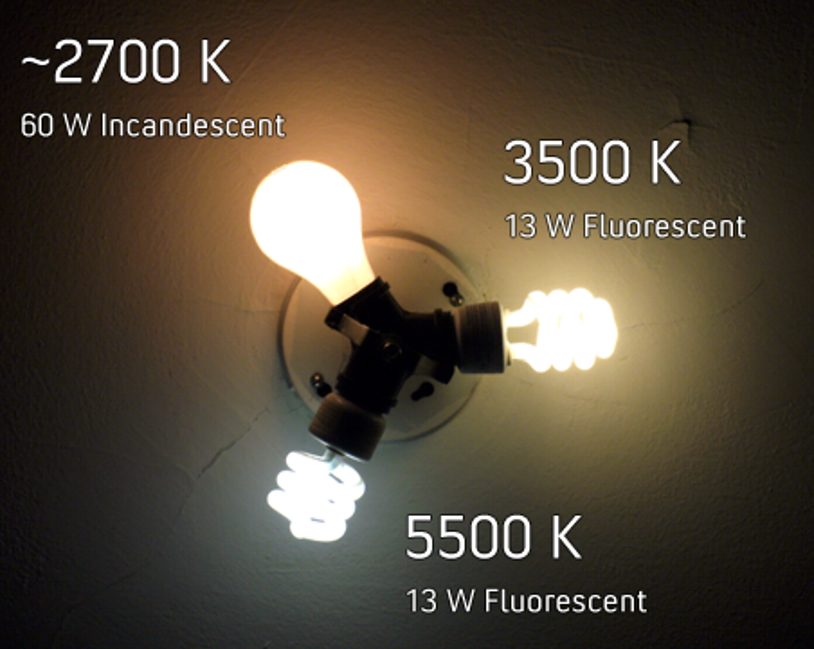Lamps are often rated by:
Power consumption and light output – in Watts (Unit of electricity consumption), Lumens, Lux or Candela (Units of light output), Lumens per Watt (A derived unit that indicates the luminous efficiency of the lamp).
Color Rendering Index – A measure of how efficient is a lamp at reproducing colors.
Color Temperature – an indicator of visual light color
Of late, a new parameter called ‘Pupil Lumens’ has entered the picture. The light output of a lamp is expressed in photopic lumens. Pupil lumens on the other hand measure the impact of different wavelengths of the eye on vision under Mesopic light conditions.
You can refer to other resources on this site to know more about power consumption, light output, Color Rendering Index and Pupil Lumens. Below is a discussion of Color Temperature meant to help you choose the right LED light bulb.
Color Temperature
Color temperature of a light source is “the temperature of a black body radiator in Kelvin (K) that radiates light of a hue that is similar to that produced by the light source.” This definition may be a bit confusing for people not familiar with the physics behind light. A simpler explanation of color temperature would therefore be more appropriate.
When the first developments in lighting technology occurred, the only way to produce light was to heat an object. When an object was heated – either by passing a current through an electric wire or by other means – it first became ‘red hot’ and then went on to become ‘white hot’ as the heating continued.
A ‘red hot’ object has a temperature close to 600 degrees centigrade. By comparison, a ‘white hot’ object may have a temperature of 7000 degrees or more. If you have seen a glowing ember (600 centigrade temperature, with very little light output), it is easy to understand that at lower temperatures almost all the energy is converted to heat. At higher object temperature, the production of light improves. Thus, energy from the sun consists of 40% light and 60 % heat while a light bulb emits 10% or less energy as light and 90 % as heat.
Here are the temperatures of a few light sources
| Light Source |
Temperature |
|
Glowing ember |
900K |
|
Match flame |
1700K |
|
Incandescent Bulb |
2700-3300K |
|
Sun at sun rise or sun set |
3000K |
|
Sun at noon |
6500K |
The incandescent bulb is very close to the ideal black body radiator. Other sources of light including metal halide, fluorescent and LED lights produce lights by processes other than heating. Instead of color temperature, the term Correlated Color Temperature (CCT) is at times applied to these light sources and is a good yardstick for comparing different sources of light.
Lights of 3 different Color Temperatures. Note that the light from 5500 K lamp is bluish in color.

Importance of Color Temperature
Color temperature is particularly important in photography and desktop publishing. Differences in color temperature can result in variations in color rendering.
In homes and offices, color temperature of lights is important as different colors of light have different psychological impacts and are designated as ‘warm’ or ‘cool’. Ironically, the so-called ‘warm lights’ have a lower ‘Color Temperature’ while the ‘cool lights’ have a higher ‘Color Temperature’. Warm and cool thus refers not to the color temperature but to psychological attributes of lighting. The light from wood burning fires and incandescent bulbs is yellowish in color.
The human mind, conditioned by thousands of years of social evolution, accepts yellow-ish light as warm and inviting. On the other hand, day white light is associated with cleanliness and efficiency - as in hospitals. IT is also depending on cultural and regional backgrounds as people form countries nearer to the equator prefer cold white light sources than warm white lights.
The choice of light color temperature is governed by the look you wish to create in an area. Lights of different color temperature are described by their similarity to known sources or with typical adjectives. The table below can help you choose the right lamp for your needs


